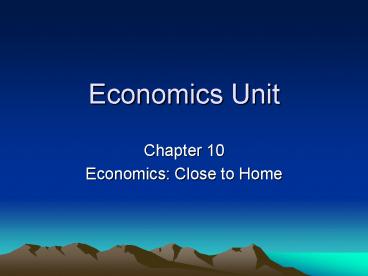Economics Unit - PowerPoint PPT Presentation
1 / 32
Title: Economics Unit
1
Economics Unit
- Chapter 10
- Economics Close to Home
2
Economics
- The study of our efforts to satisfy our unlimited
wants through the use of limited resources. - Wants gt Resources Scarcity, the fundamental
problem of economics! - Scarcity forces us to make decisions
- What to produce?
- How to produce it?
- Who gets what is produced?
- Goods products, such as sugar, cars.
- Services hairstylist, taxi
3
Opportunity Cost
- Opportunity cost is the loss involved in choosing
one thing rather than another. It is the result
of scarcity! - For example, the opportunity cost of watching the
hockey game is the opportunity lost of studying
for your test! - Buying the yellow shirt instead of the red one
the opportunity cost of the yellow shirt is the
opportunity lost of the red one. - Sometimes as consumers we make the mistake of
impulse buying, spur of the moment purchases,
without considering opportunity cost.
4
(No Transcript)
5
(No Transcript)
6
(No Transcript)
7
Supply and Demand
- Demand (consumers) the amount consumers are
willing and able to buy at a particular price. - Supply (producers) The amount producers are
willing and able to produce at a particular price.
8
Demand and Supply CurvesSee page 144 text
9
Equilibrium Price
- Equilibrium Price refers to the price at which
buyers and sellers agree. - Best for the economy because it reduces waste.
We sell what we produce! - Law of Demand
- As price goes up, demand goes down
- As price goes down, demand goes up
- Law of Supply
- As price goes up, supply goes up
- As price goes down, supply goes down
- Hidden Market/Substitute Effect
10
(No Transcript)
11
Investing
- Principal the original sum invested
- Interest money earned on the principal
invested, (based on interest rate) - Compound Interest interest on your interest
12
Chapter 11The Atlantic Economy
- Sectors of Our Economy
- Primary Industry
- Secondary Industry
- Tertiary Industry
- Quaternary Industry
13
Primary Industry
- PRIMARY INDUSTRY activities in which people
use, extract, harvest natural resources such as
water, soil, fish, animals, plants, trees. - Products are only slightly altered before they
are used. - Ex fishing, farming, mining, agriculture.
- Natural Resources materials found in the natural
environment that humans can use to satisfy their
needs and wants. - Natural resources formed the basis of the regions
economy for centuries (100s of years). Some
influence our culture ex. Fishing - Today some primary industries are in decline but
others remain important to the economy. A decline
can be because of declining resources, a change
in consumer demand, or competition from other
countries.
14
- Primary industry today is changing in the
following ways - fewer manual workers are needed
- use of technology
- higher skill level and education needed
- Fishing decline in ground fishing led to
increase in aquaculture (fish farming). - Forests protect the forest by assigning each
province an allowable annual cut (AAC) - - many factors are used to calculate this (p.
162) - Mining different types of mining are used to
get minerals out of the ground. - - minerals are manufactured into many things
- Farming includes 3 stages
- inputs anything needed to grow the crop
- process what farmers do to bring crops to
maturity - out puts crops produced and any waste
15
(No Transcript)
16
Secondary Industry
- SECONDARY INDUSTRY process raw materials into
finished goods. - products are manufactured into goods that are
substantially different from original materials - goods are worth more (value added).
- Ex manufacturing, construction, transportation
and utilities (hydro and gas) - Related closely to primary industry.
- Ex fishing ? food processing, ship building
17
(No Transcript)
18
TERTIARY INDUSTRY
- TERTIARY INDUSTRY enables customers to obtain
and use finished products - workers provide services rather than goods
- ex sales, repairs, banking, insurance, tourism,
hospitality, clerks, doctors
19
(No Transcript)
20
QUARTERNARY INDUSTRY
- QUARTERNARY INDUSTRY involves specialized
technology - Ex of workers research scientists, computer
software designers. - Often grouped with Tertiary industry as workers
provide services rather than goods.
21
(No Transcript)
22
Linking them together
- Both tertiary and quaternary are linked to
primary and secondary sectors. - Ex fishing rely on weather forecasters for
ocean conditions - rely on mechanics and technicians to maintain
equipment - plant owners rely on marketing specialists to
help find new opportunities to sell their fish
23
GDP and GNP
- GDP or Gross Domestic Product is the total value
of goods and services produced within a given
area in a given year. - Used to measure economic growth!
- GNP or Gross National Product is the total value
of all goods and services produced by Canada in a
given year, including that of Canadian companies
operating in other countries. - Entrepreneurs people who turn ideas in
businesses.
24
Chapter 12 Our Economic Outlook
- Sabian Cymbals, NB
25
Trickle Down Effect
26
Seasonal Work
- We have a resource based economy so many jobs are
seasonal, where workers are employed for only
part of the year.
27
(No Transcript)
28
(No Transcript)
29
(No Transcript)
30
Out migration The Brain Drain
31
Transfer Payments
- HavesBC, Alberta, NL
- to
- Have Nots All other provinces
- Equal access for all Canadians to health care and
education, the 2 biggest expenditures for every
province. - AKA equalization payments, it negates economic
diversity.
32
ACOA and NAFTA































